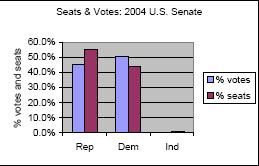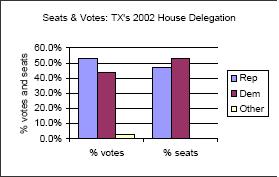What Do Votes Have to Do With It?
Democrats� Probable National Majorities May Not Result in Control of Congress
On November 7, Americans will elect all 435 Members of the U.S. House of Representatives and 34 U.S Senators. Due to the malapportionment required by the U.S. Constitution for Senate elections and the vagaries of single-member district, winner-take-all elections for the House, it is quite possible that Democrats will win clear majorities of the national popular vote in races for both the House and Senate � on the order of 53% to 47% - but not majorities of seats in either body.
Minority Rule in the U.S. Senate
 Republicans currently hold 55 out of 100 seats in the Senate, yet Democrats won 50.5% of all votes cast (two-party vote) in Senate races in 2000-2004. By contrast, the Republican majority rested on 49.5% of the two-party vote. Nationally, it took 725,828 votes to elect a Republican and 1,017,050 to elect a Democrat.
Republicans currently hold 55 out of 100 seats in the Senate, yet Democrats won 50.5% of all votes cast (two-party vote) in Senate races in 2000-2004. By contrast, the Republican majority rested on 49.5% of the two-party vote. Nationally, it took 725,828 votes to elect a Republican and 1,017,050 to elect a Democrat.In 2006, Democrats are favored to sweep to big margin victories in most big state Senate races and gain seats overall. But, once again, their likely popular vote majority in Senate races from 2002-2006 may not translate into a majority of seats. When states have two senators regardless of size, it is easy to have such a disconnection.
Minority Rule in the U.S. House of Representatives
The popular vote majority party also can lose the chamber in U.S House races. In 2006, for example, Democrats are widely expected to win the national two-party vote � both because of national poll preferences and because they are running more than 30 more House candidates than Republicans. But if Democrats only win a slim majority of the national House vote, they almost certainly will fail to win a majority of House seats. Indeed, they likely will fall short of a seat majority even if winning close to 53% of the two-party vote.
One reason is the simple power of incumbency: when your opposition party starts off with more incumbents who typically run 5% to 8% above the partisan projection in their districts, you are at a disadvantage. But an even bigger reason is our partisan geography. Democratic voters are more likely to be geographically concentrated in urban and suburban areas and as a result live in more naturally �packed� districts. By contrast, Republican voters are more efficiently distributed for the purpose of winning congressional seats. Thus, George Bush could lose the national popular vote in 2000, but carry 47 more of the 2002 congressional districts � a pattern of Republican advantage that in fact was even more pronounced in the 1970s, when far greater ticket-slitting concealed its impact. As another measure, the average margin of victory in 2004 in a Democratic-held district was 45% points as contrasted with 37% points for winning Republicans.

Examples from the states
In 2004, Connecticut Democratic candidates won a 55% majority of votes statewide. Republicans took just over 44%. Despite a comfortable majority for Democrats, the state�s delegation is majority Republican.
Texan Republicans experienced their own �wrong winner� election in 2002 when, despite accounting for over 53% of votes in U.S. House races, they won only 15 of 32 seats. Democrats won a 17-seat majority with under 44% of votes.